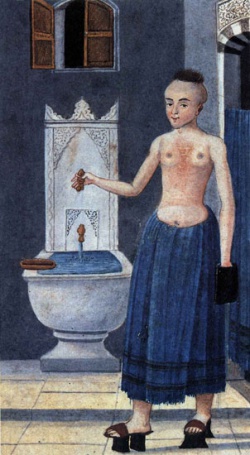Tellak: Difference between revisions
No edit summary |
(Changed the format of a word from italic to bold) |
||
| (9 intermediate revisions by 2 users not shown) | |||
| Line 1: | Line 1: | ||
[[Image:Tellak - Huban name.jpg|thumb|250px|right|'''Tellak''' | [[Image:Tellak - Huban name.jpg|thumb|250px|right|'''Tellak'''. Detail of an illustration from the ''Hubanname'' (''The Book of the Handsome Ones''), an 18th-century [[Pederasty#The Ottoman Empire|homoerotic]] work by the Turkish poet [[Fazyl bin Tahir Enderuni]].]] | ||
Traditionally, '' | Traditionally, a ''tellak'' was a young male masseur who soaped and scrubbed the clients of a ''[[hammam]]'', a place of public bathing associated with the culture of the [[Ottoman Empire]]. They were usually adolescent boys recruited from among the ranks of [[Dhimmi|non-Muslim subject nations]], counting among them [[Greeks]], [[Armenians]], [[Jews]], [[Albanians]], [[Bulgarians]], [[Romani people]] and others. | ||
Besides their role as washers, ''tellaks'' often acted as [[Prostitution|sex workers]]. Ottoman texts dedicated to the subject matter of ''tellak'' [[catamites]], such as the ''Dellakname-i-Dilküşa'', an 18th-century work by Dervish Ismail Agha (held in the Ottoman Archives of Süleymaniye, Istanbul), recorded their names, physical features and national origin, how many times they could bring their customers to orgasm, and the details of their fees and services. | |||
At times the relationship between a tellak and his client became intensely personal. | At times the relationship between a ''tellak'' and his client became intensely personal. For example, it is recorded that in the mid-18th century, a [[janissary]]—a member of an elite corps in the standing army of the Ottoman Empire—had a ''tellak'' for a lover. The latter was kidnapped by the men of another regiment and given over to the use of their commander. A days-long battle between the two janissary regiments ensued, which was brought to an end only by the intervention of the Sultan, who had the ''tellak'' hanged. | ||
The tellak | The role of ''tellak'' lost its sexual aspect in the early years of the twentieth century, as a result of the increasing westernization of the [[Turkish Republic]], and is now filled by adult attendants who specialize in more prosaic forms of scrubbing and massage, but the Turkish term ''hamam oğlanı'' (bath boy) still indicates a homosexual male. | ||
==See also== | ==See also== | ||
*[[ | * [[Ghilman]] | ||
* [[Köçek]] | |||
* [[Pederasty]] | |||
*[[Köçek]] | |||
*[[ | |||
[[Category:Ottoman Empire]] | [[Category:Ottoman Empire]] | ||
Latest revision as of 09:39, 18 February 2020

Traditionally, a tellak was a young male masseur who soaped and scrubbed the clients of a hammam, a place of public bathing associated with the culture of the Ottoman Empire. They were usually adolescent boys recruited from among the ranks of non-Muslim subject nations, counting among them Greeks, Armenians, Jews, Albanians, Bulgarians, Romani people and others.
Besides their role as washers, tellaks often acted as sex workers. Ottoman texts dedicated to the subject matter of tellak catamites, such as the Dellakname-i-Dilküşa, an 18th-century work by Dervish Ismail Agha (held in the Ottoman Archives of Süleymaniye, Istanbul), recorded their names, physical features and national origin, how many times they could bring their customers to orgasm, and the details of their fees and services.
At times the relationship between a tellak and his client became intensely personal. For example, it is recorded that in the mid-18th century, a janissary—a member of an elite corps in the standing army of the Ottoman Empire—had a tellak for a lover. The latter was kidnapped by the men of another regiment and given over to the use of their commander. A days-long battle between the two janissary regiments ensued, which was brought to an end only by the intervention of the Sultan, who had the tellak hanged.
The role of tellak lost its sexual aspect in the early years of the twentieth century, as a result of the increasing westernization of the Turkish Republic, and is now filled by adult attendants who specialize in more prosaic forms of scrubbing and massage, but the Turkish term hamam oğlanı (bath boy) still indicates a homosexual male.